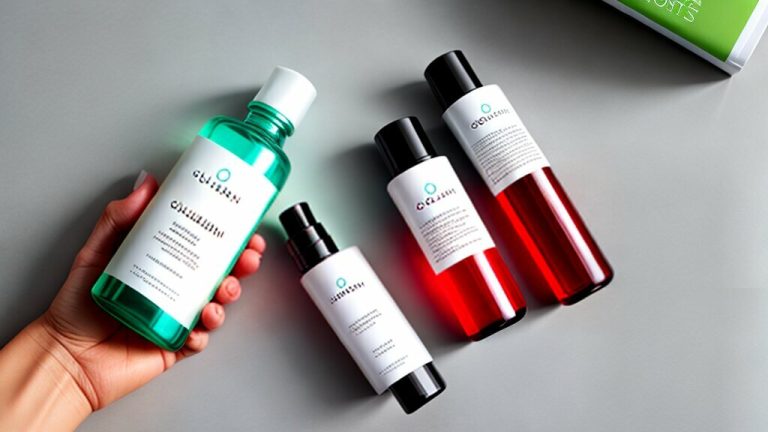Best Serums to Use After Dermaplaning: Enhance Your Skincare Routine
Dermaplaning is a popular skincare treatment that uses a tiny sterile blade to remove dead skin cells and peach fuzz from the face. This process leaves the skin feeling smooth and refreshed, but it also creates tiny micro-channels that enhance the absorption of skincare products.
This is where serums come in. Serums are lightweight, highly concentrated skincare products with active ingredients that penetrate the skin deep. Using serums after dermaplaning can enhance the effectiveness of your post-treatment skincare routine and provide a range of targeted benefits.
As a nurse caring for a client with a serum containing potassium level of 3.1 meq/l, it’s important to note that serums should be incorporated into the skincare routine under the guidance of a healthcare professional. With that in mind, let’s explore some of the best serums to use after dermaplaning.
Key Takeaways
- Dermaplaning enhances the absorption of skincare products.
- Serums are highly concentrated skincare products that provide targeted benefits.
- Serums should be used under the guidance of a healthcare professional.
Understanding Serum Potassium Levels and Nursing Interventions for Potassium Imbalance
As a nurse, monitoring a client’s serum potassium levels is essential to ensure patient safety and prevent potential complications. A potassium level of 3.1 meq/l is considered low and requires appropriate nursing interventions to address the potassium imbalance.
Potassium is an crucial electrolyte which helps regulate muscle and nerve function. A potassium imbalance can lead to various symptoms, such as muscle weakness, fatigue, and irregular heartbeat. In some cases, it can even lead to cardiac arrest or death.
When caring for a client with low serum potassium levels, the nurse must assess the client’s condition and implement appropriate interventions. This may include administering potassium supplements, adjusting the client’s diet, or monitoring electrolyte levels closely.
| Potassium Imbalance Nursing Interventions | Notes |
|---|---|
| Administer potassium supplements as ordered | Oral or intravenous (IV) supplements may be prescribed to increase serum potassium levels. |
| Monitor ECG for changes in heart rhythm | A low serum potassium level can cause irregular heartbeat, and an ECG can help detect any abnormalities. |
| Assess for signs of muscle weakness or fatigue | Low potassium levels can lead to muscle weakness, fatigue, and cramps. Assessing the client’s physical condition can help determine the severity of the imbalance. |
| Adjust the client’s diet to include potassium-rich foods | Foods like bananas, potatoes, and spinach can help increase potassium levels in the body. |
| Monitor electrolyte levels closely | Regular electrolyte monitoring is necessary to ensure serum potassium levels are within a safe range. |
Monitor electrolyte levels closely Regular electrolyte monitoring is necessary to ensure serum potassium levels are within a safe range.
Remember that potassium imbalances can be life-threatening, and immediate nursing interventions must address the issue. By monitoring serum potassium levels and implementing appropriate interventions, nurses can help keep clients safe and healthy.
The Role of Serums in Skincare
Serums play a important role in any skincare routine. These lightweight formulas contain a higher concentration of active ingredients that pierce deeply into the skin, delivering targeted benefits. Unlike moisturizers, primarily designed to hydrate the skin’s surface, serums are specifically formulated to address various skincare concerns.
Whether you’re looking to combat signs of aging, brighten your complexion, or improve skin texture, there’s a serum for you. Serums typically contain antioxidants, peptides, and vitamins, which work together to nourish and rejuvenate the skin.
What makes serums different from other skincare products?
The main difference between serums and other skincare products is their rich concentration of active ingredients. Serums typically contain smaller molecules than moisturizers or creams, which can penetrate deep into the skin’s layers. This allows them to deliver powerful benefits without feeling heavy or greasy on the skin.
Serums are also highly customizable, allowing you to choose a formula tailored to your skin concerns. Whether you’re looking for a serum to combat fine lines, fade dark spots, or hydrate dry skin, a serum can help.
How can serums benefit your skin?
Serums can provide a range of skincare benefits, depending on the ingredients they contain. Here are just a few ways that incorporating a serum into your routine can benefit your skin:
- Hydration: Serums containing hyaluronic acid can help hydrate the skin, leaving it plump and glowing.
- Anti-Aging: Serums containing peptides and retinol will help to boost collagen production, minimizing the look of fine lines and wrinkles.
- Brightening: Serums containing vitamin C and niacinamide can help to brighten the skin, minimizing the look of dark spots and hyperpigmentation.
- Firming: Serums containing collagen and peptides can help improve skin elasticity and firmness, promoting a youthful appearance.
How can you incorporate serums into your skincare routine?
To achieve the maximum benefits of a serum, it’s essential to apply it correctly. Here are some tips for incorporating serums into your skincare routine:
- Cleanse your skin thoroughly before applying a serum.
- Apply a small amount of serum on your fingertips and gently rub it on your skin.
- Let the serum to fully absorb before applying moisturizer or sunscreen.
- Use serums in the morning and evening, depending on your routine and the instructions on the bottle.
By including a serum into your skincare routine, you can enhance the effectiveness of your regimen and enjoy healthier, more radiant skin.
Choosing the Right Serums After Dermaplaning
Dermaplaning takes off the topmost layer of dead skin cells and vellus hair, leaving off a smooth and bright skin. However, it also opens up the skin to allow deeper penetration of skincare products. Choosing suitable serums after dermaplaning is essential to maximize this opportunity.
The first consideration is your skin type. Choose for serums with hydrating ingredients like hyaluronic acid or glycerin for dry skin. If you have oily skin, consider a serum with gentle exfoliating properties, like salicylic or lactic acid, to prevent clogged pores.
Next, consider any specific skin concerns you have. Vitamin C is one of the best ingredient for brightening and reducing dark spots. To address signs of aging, look for serums with retinol or peptides to boost collagen production and improve elasticity. For firmer, tighter skin, try a serum with collagen or elastin.
Finally, check the ingredients list for any possible irritants or allergens. Avoid serums with alcohol, fragrance, or essential oils if you have sensitive skin. If you need clarification on an ingredient, do a patch test on a small skin area before applying it all over your face.
Remember, using suitable serums after dermaplaning can significantly enhance the benefits of your skincare routine. Take some time to research and find the best options for your skin type and concerns.
Serums for Hydration and Moisture
Healthy skin is hydrated skin. Keeping your skin nourished and hydrated is crucial for a glowing and youthful appearance. However, with so many products on the market, figuring out where to start can take time. Post-dermaplaning, the suitable serum can help maintain the natural moisture balance of your skin, giving it the hydration it needs.
Serums for Hydration
Serums that contain hyaluronic acid are an excellent choice for those needing to boost hydration. Hyaluronic acid is a type of naturally forming substance in the skin that binds moisture to cells, keeping them hydrated. When combined with other hydrating ingredients such as glycerin and ceramides, these serums can provide long-lasting moisture to the skin.
| Key Ingredients for Hydration: | Hyaluronic acid | Glycerin | Ceramides |
|---|
After dermaplaning, your skin may be more prone to dryness due to the removal of the outermost layer of dead skin. Using a serum that contains hydrating ingredients can help restore your skin’s natural moisture and keep it looking healthy and supple.
Maintaining Skin Moisture After Dermaplaning
After dermaplaning, it’s crucial to keep your skin well-moisturized and hydrated. Hydrating serum and a moisturizer can help lock in moisture and prevent dryness. It’s also essential to avoid hot water and strong soaps, as they can strip the skin of its natural oils. Instead, use lukewarm water and a gentle cleanser to keep your skin clean and hydrated.
- Use a hydrating serum with key ingredients, like hyaluronic acid, glycerin, and ceramides, to help boost the moisture levels in your skin.
- Combine your serum with a moisturizer to lock in hydration and prevent dryness.
- Stay away from hot water and strong soaps; use lukewarm water and a gentle cleanser to keep your skin clean and hydrated.
Hydrating serums can help maintain your skin’s moisture balance when used correctly, keeping it healthy and radiant.
Serums for Anti-Aging and Wrinkle Reduction
If you’re looking for a way to minimize the look of wrinkles and fine lines, consider incorporating anti-aging serums into your post-dermaplaning skincare routine. These serums stimulate collagen production and promote skin rejuvenation, resulting in a youthful appearance.
Some of the key ingredients to look for in anti-aging serums include retinol, peptides, and vitamin C.
Retinol, is a form of vitamin A, which is a potent anti-aging ingredient that helps to increase skin cell turnover and minimize the look of wrinkles. Peptides are amino acid compounds that help to stimulate collagen production. At the same time, vitamin C is a powerful antioxidant which helps to secure the skin from environmental damage and brighten the complexion.
When using anti-aging serums, following the instructions carefully and starting with a low concentration to minimize the risk of irritation is essential. Gradually increase the concentration over time as your skin becomes accustomed to the product.
Always apply sunscreen after using anti-aging serums, as these products will make the skin more sensitive to UV damage. Consistent use of a suitable anti-aging serum will help you get a more youthful and radiant complexion.
Serums for Brightening and Even Skin Tone
A suitable serum can make all the difference to get a brighter and even skin tone. Serums designed to brighten and even out the complexion are formulated with ingredients like vitamin C, niacinamide, and kojic acid, which work to reduce hyperpigmentation and can give your skin a radiant glow.
Vitamin C is a powerful form of antioxidant which helps to secure the skin from free radical damage and stimulate collagen production. Serums with vitamin C can help to lighten dark spots and improve overall skin tone.
Niacinamide, or vitamin B3, is another popular ingredient in brightening serums. It has been shown to reduce hyperpigmentation and improve the look of lines and wrinkles.
Kojic acid is a natural skin lightener found in some serums. It works by controlling the melanin production, the pigment that gives the skin its color. This can help to fade dark spots and even out the skin tone.
When using a brightening serum, it’s essential to be patient, as results may take some time to show. Additionally, it’s essential to use sunscreen daily to protect the skin from further damage, as brightening ingredients might make the skin more sensitive to the sun.
Serums for Firming and Tightening
Incorporating a suitable serum into your skincare routine after dermaplaning can make a big difference if you want to firm and tighten your skin. Here are some of the key ingredients to look for:
| Ingredient | Benefits |
|---|---|
| Peptides | Stimulate collagen production and improve skin elasticity |
| Collagen | Provides a temporary “plumping” effect to the skin |
| Retinol | Helps to smooth fine lines and wrinkles by promoting cell turnover |
Serums containing these ingredients can help rejuvenate aging skin and promote a youthful appearance. Remember that while these serums can be effective, it’s essential to use them as directed and not overuse them, as they can cause irritation or other adverse effects if used excessively.
Using Serums for Firming and Tightening
When incorporating firming and tightening serums into your skincare routine after dermaplaning, follow these tips:
- Cleanse your face thoroughly before applying serum.
- Take a small amount of serum to your fingertips and gently massage it on your face.
- Let the serum to soak fully before applying moisturizer and sunscreen.
- Use the serum according to the directions on the label – some should only be used once a day or every other day.
You can achieve a firmer, more youthful complexion by carefully selecting and using suitable serums after dermaplaning. As always, seek professional guidance if you have concerns about your skincare routine.
Incorporating Serums Into Your Skincare Routine After Dermaplaning
After dermaplaning, it’s essential to incorporate serums into your skincare routine to increase the benefits of the treatment. Here are some tips on how to do so:
Step 1: Cleanse Your Face
Begin by cleansing your face. Use a cleanser to wash off dirt, oil, or makeup residue.
Step 2: Apply Toner (Optional)
If you typically use a toner, apply it after cleansing. Toner will help to balance out the skin’s pH level and prepares the skin for serum application.
Step 3: Apply Serum
Apply your chosen serum to your face and neck, avoiding the eye area. Use gentle, upward strokes to apply the serum evenly.
Step 4: Allow Serum to Absorb
Let the serum to soak into your skin before applying any additional skincare products. This will help ensure that the serum effectively penetrates the skin and delivers its benefits.
Step 5: Apply Moisturizer and Sunscreen
Once the serum is soaked fully apply your moisturizer and sunscreen as usual. These products will help seal the serum and protect your skin from further damage.
Seek help from a healthcare professional if you have questions or concerns about incorporating serums into your skincare routine after dermaplaning. They can provide personalized suggestion based on your skin type and individual needs.
Other Considerations and Precautions
While serums can provide many benefits to the skin after dermaplaning, there are some considerations and precautions to keep in mind:
- Always patch-test new serums before applying them to your entire face.
- Avoid harsh or abrasive treatments immediately after dermaplaning, as the skin may be more sensitive.
- If you feel any skin irritation or allergic reactions after using a serum, stop use immediately and seek professional guidance.
It’s also important to note that while serums can help achieve specific skin care goals, they should not be used as a substitute for overall skin health. Maintaining a regular skincare routine that includes cleansing, moisturizing, and sun protection is essential to keep the skin looking its best.
Conclusion
Using serums after dermaplaning can be a game changer for your skincare routine. They offer targeted benefits for specific skin concerns and enhance the effectiveness of the dermaplaning treatment. Choosing the suitable serums for your skin type and concerns is essential, and following the recommended application guidelines.
Remember, as a nurse, your role is crucial in patient care, keeping track of electrolyte levels and administering appropriate interventions. You should always consult a healthcare professional about any concerns or questions.
Don’t be afraid to try new serums and experiment with your skincare routine, but also be mindful of precautions and potential side effects. Incorporating serums after dermaplaning can be an excellent addition to your skincare regimen, and with the proper guidance, you can achieve healthy, glowing skin.

I’m Carol Edwards, the force behind SerumDeals.com – your one-stop for all things serum. With over a decade of obsessing over skincare, I’m here to demystify sensational skin. I dig deep, testing serums in action. Beyond the surface, I uncover actual effectiveness. From ingredient breakdowns to real-life testing, my reviews are your trustworthy guide. Whether you’re a skincare rookie or diving into specifics like anti-aging or hydration, I’ve got your back with accurate info. Let’s simplify the serum journey together. SerumDeals.com isn’t just a site; it’s a hub for thriving skincare aficionados. Join me to uncover vibrant skin, one serum at a time.
Glowingly, Carol Edwards





